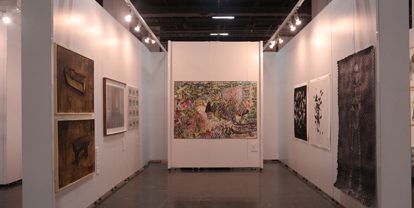Contemporary Istanbul 2018
Group Exhibition
September 20 — September 23, 2018
Mohsen Gallery at Contemporary Istanbul
September 20-23, 2018
In its participation in the 13th Contemporary Istanbul, which will be held from the 20th to the 23rd of September, Mohsen presents Arya Tabandehpour, Sasan Abri, Mojtaba Amini, Gohar Dashti, and Behrang Samadzadegan.
Sasan Abri deals with urban spaces in most of his series. The locations could be anywhere. The difference between “Expedition in an Urban Area” and his other series such as “Exposed” and “Dormant Yellow” is in its wandering people who have turned their backs on the camera in total disregard of its presence. People are there and are not there. Their faces are not recognizable and they avoid being seen. The narratives of these Polaroid images are momentarily with some kind of visual improvisation. Through the use of camera and certain techniques the images are made blurry. Two slices of the scene, the day, or the passing of a person that has happened spontaneously are juxtaposed. In these nine works, each frame contains two images that are separate and continuous at the same time. They are set on an uneven, deformed, and scrapped background like that of a city or a neighborhood. For Sasan Abri, the stories of the Polaroid and the photographic process are analogous to a game. After seeing the results, you would realize that you have either overcome the moment or you are defeated by it.
Arya Tabandehpour is another artist present in the event. He considers the body through fantasy and with its fragile forms: in a lack of stability, in the deficiency of the body, in obliteration, in gradual aging of its functions and its organs, and also in a death that will inevitably come. “Bones” is the title of a series in which the concepts of decay, impotence, weakness, and disability of the body is addressed. In these life-size images, the artist weaves two situations together: the visible (flesh) and the invisible (bones). This woven image neither seeks to reproduce “something beautiful” nor is he trying to deny it; this body is nothing but some beautiful nature that is doomed to extinction.
Gohar Dashti, however, considers destruction and rejection in conjunction with growth and appearance of something new from the ashes of ruins. In the photographs of her “Home” series, the artist emphasizes elimination of humans, combining naked, abandoned, and old spaces with living plants in order to remind us that life still goes on in the nakedness of these silent, forsaken places. Even though these spaces and houses are abandoned, nature is still alive in them. And perhaps it is only nature that keeps on living in them.
When art tells the story of disaster, it has three narratives: one seeks to bring out disaster so that something happens faster; the other prevents the disaster in order to preserve a situation; and finally narrates that which happens after the disaster, destruction, and tragedy. In his collages, Mojtaba Amini depicts human disasters in their most abstract forms. However, they do not intend to provoke, change, or even preserve a situation, but they are there for the remembrance of a tragedy that has already happened, the sorrow of which has remained behind like ashes. The calamities that happened in a mine and the abuse of humans in the time of war are among the things that Amini addresses in this works. In retelling these traumas, the artist achieves a fantastic situation in which disaster is the beginning of survival.
Behrang Samadzadegan is a painter who presents his interpretation of Iran’s history in his recent series, “Seizure,” by fantasizing about documents from Iran’s political history and an imaginary journey towards a fictitious utopia. He questions, engages, destroys, and creates. He does not believe that the unchangeable determinism of watercolor is in conflict with events, surrendering, victories and defeats, and astonishments in history. When the aesthetic games come into play, historical factors start to fade. Similar to the intertwined quality of watercolor, the events intermix in these paintings: occurrences that are related to one another, recurring in various shapes and in different times.
All these series long for something, some scene, or some occurrence, and fantasize about them. Fantasy, memory, ideology, utopia, and hope are different manifestations of human imagination that take our hands and carry us to different places.
